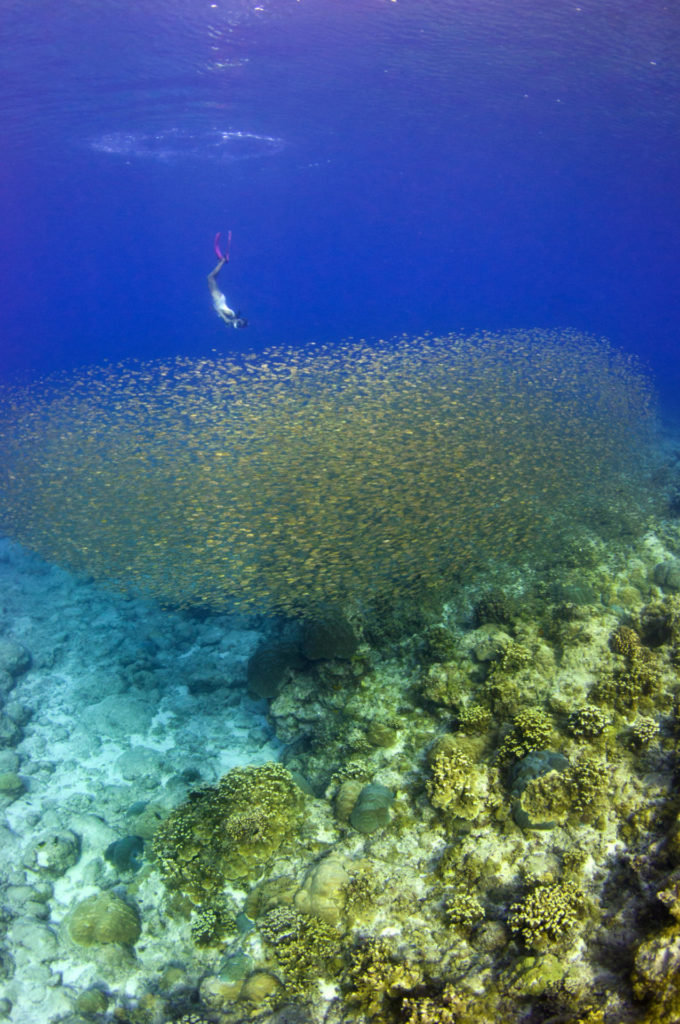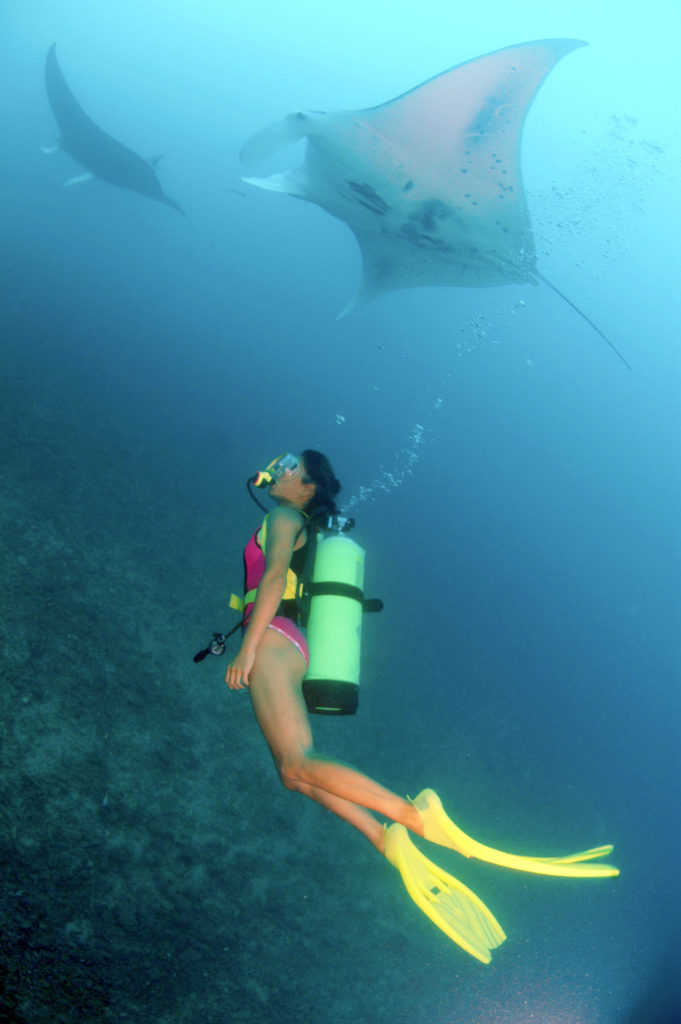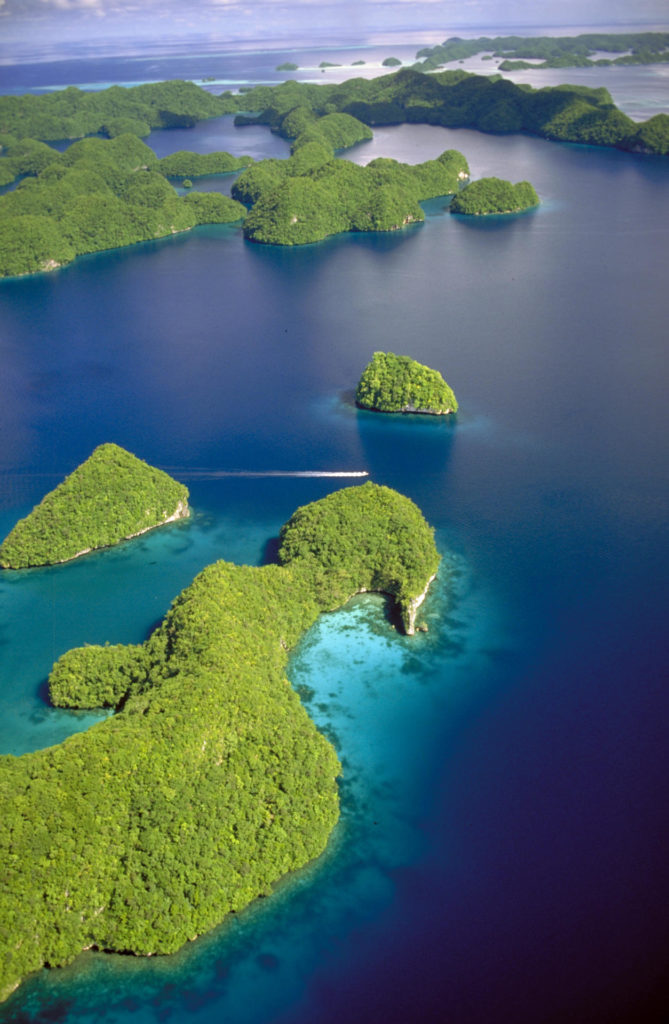Tim Rock takes us on the second leg of his island-hopping adventure across Micronesia to explore the Big Island, the beautiful Northern Marianas and the world-famous dive destinations of Yap and Palau.
Part Two: Guam, CNMI, Yap and Palau
In the first part of our series we looked at eastern and central Micronesia with the Republic of the Marshall Islands and the Federated States of Micronesia states Kosrae, Pohnpei and Chuuk (Truk Lagoon). For the most part these isles are quiet and not overly developed.
The islands to the west include Guam, Commonwealth of the Northern Mariana Islands (specifically Saipan & Rota), the FSM’s Yap State and Palau. While Yap maintains a reputation of being the most traditional island in Micronesia with its stone money and traditional sailing canoes, the other islands are very popular tourism destinations that have embraced visitors in a big way.
Guam gets well over a million visitors annually, and Palau is a world-class diving destination. Daily flights, an array of hotel choices and variety in Asian and international cuisine make these destinations popular and trendy.
Guam
Guam is a U.S. territory and the most populous island in Micronesia. It hosts more than 1.3 million Asian sun worshippers a year, mostly from Japan, and they take advantage of many water sports, shopping, hiking, history tours, cultural dances and diverse fine diving.
Residents and visitors alike regularly enjoy the reefs in Guam. The Apra Harbor featured WWII shipwrecks and nice hard coral reefs. Deep drop-offs outside and a Blue Hole are punctuated by normally gin-clear water.
Dolphin watching is a favorite Guam activity as pods of dolphins break into small family units and rest in the western bays by day. Boats visit the bays, and the dolphins will swim with the bow waves and often jump and spin, thus earning their name as spinner dolphins.
One can also go into the sea without getting wet by visiting the Fish Eye Marine Park in Piti Village’s Tepungan Bay. This family attraction is at the end of a long pier that goes over the water to a multi-windowed observatory that sits 30 feet below the sea.
Tropical fish cavort by the windows, and the beautiful coral reef can be seen in the background. Across the street, the visitor center offers lunches, a dinner show complete with Polynesian dancers and a special gift with lots of Micronesian souvenirs.
Micronesia’s entry into capitalism is Tumon Bay, the Waikiki of the west. A fancy hotel row lining a shallow turquoise bay that is a marine preserve has the tinkling glasses of nightlife, good sushi bars and the world’s largest walk-through aquarium. This bay provides some nice snorkeling in the marine park.
Because Guam gets so many visitors, there is lots to do from sky diving to ocean diving. Visit the secluded northern beach or sun with the masses at Tumon Bay. Visit Alupang Island beach and Jetski out its channel from the shores of the Santa Fe Hotel or just watch the sunset and have a drink at the hotel’s west facing bar and restaurant.
While by far the most populated island in Micronesia, Guam still has a lot of natural beauty and lots of history. Guam is United Airlines’ hub for the region.
Northern Mariana Islands
The islands in the northwest Pacific called the “Caribbean of Japan” are known as the Mariana Islands. For the most part, they are rugged and largely unpopulated, running 560 miles from Guam to the northernmost Farallon De Pajaros.
As Guam is considered an independent U.S. territory, the main CNMI isles are the ones in the populated south with Rota, Saipan and Tinian. The group is compact, consisting of a single chain.
The islands have high volcanic cones. Some are geographically active with smoldering volcanoes in the north. Known for their clear waters, reefs, caves and war wrecks, Saipan, Rota and Tinian are a favorite of Asian divers and snorkelers.
The climate in the CNMI, or Commonwealth of the Northern Mariana Islands, has been described as one of the most favorable in the world. Hot, sunny days and cool nights are the norm.
In the south, these geographically quiet islands are alive with marine life and the clearest waters found anywhere. The two most popular islands are Saipan and Rota, where old war wrecks, pelagic congregations and warm waters beckon scuba divers.
The islands themselves offer a rugged beauty with uplifted spines and plateaus creating a center spine with thick jungles. Cascading waterfalls flow from some of Rota’s heights. Saipan is pocked with caves. Tinian has stunning cliffs that fall to the deep blue sea.
People come here to play golf, mountain bike and hike and explore World War II battle sites. Also, there are some lush botanical gardens here. Beach activities are myriad, and the water is warm, so everyone can enjoy the sea.
The island of Saipan is the capital of the Commonwealth of the Northern Mariana Islands (CNMI) and is a quick 45-minute hop by United turbo-prop jet from Guam.
The PIC hotel on the west coast of Saipan has a large water park, punctuated by a replica of an ancient Manila galleon, a tribute to a gold ship that sank on the nearby coast. But whether it be treasure or bountiful marine life, Saipan is a place that holds many secrets beneath its sea.
At night, get away from the city light and look to the sky. The heavens are as clear as the water. Stargazers are in for a treat. The Southern Cross and Orion punch through the blackness, and the Milky Way is absolutely incredible, flowing across the universe in a shimmering array of creation.
Yap
After Truk, the United Island Hopper finishes in Guam, but it is easy to continue on the next gem in the FSM crown, Yap State. It is but an hour and 15 minutes from Guam by air, but is truly the proverbial world away in terms of culture and many other factors that combine to make this one of the world’s unique destinations.
Known for having banks of huge stone discs, this stone money island is one of the most traditional in Micronesia. Village dances can still be seen and many outer islanders wear colorful loincloths, called thu’us. Women wear woven skirts made from handlooms, and a few older main island Yapese women still wear grass skirts in the villages.
A new stone path leading to a great hiking trail has been established, and the shores hold traditionally made men’s meeting houses with high thatched and pitched roofs. Most everyone in Yap chews betel nut which turns one’s saliva red and gives most Yapese a crimson smile.
Yap is famous for its manta rays whose mating season is roughly December through April, and the mantas can put on a real show around full moon. Yap is surrounded by a huge inner lagoon and barrier reef.
To get to Miil channel, where the mantas like to mate, the dive boat travels through the inner mangroves, under a bridge and past more mangroves that open to the west coast at the end. Very much a Jungle Queen experience.
A traditional dance in Yap is a pleasure to watch. Dancers dress in colorful skirts and cover their bodies in coconut oil and turmeric. The dances usually tell of some historic event, and one popular dance is about how the stone money was quarried in Palau and then brought to Yap on rafts pulled by open ocean canoes.
The peril involved in transporting the stone money greatly adds to its value. Dancers also do a rousing stick dance and really whack each other’s bamboo sticks.
Mantas, strange money and exotic dances. Yap offers a lot that easily fills a week.
Palau
The Palau islands are without a doubt among the prettiest places on earth. Spanning more than 100 miles from one tip of the archipelago to the other, this region features an amazingly beautiful atoll, a high island second only to Guam in Micronesia landmass, 700 Rock Islands and two southern limestone islands.
The south holds the famous drop-offs and has been widely dived. There is a world-class dive site called Blue Corner, considered one of the world’s best boat dives. The south also has German Channel, a favorite spot to watch manta rays feed and big schools of jacks and snapper congregate.
Plus, there’s the Rock Islands, one of the most beautiful natural formations in the world.
Babeldaob Island holds what many feel are the unexplored attractions in Palau, on land and along the outer reefs. With the new 53 miles of “Compact Road,” it now vies for attention from the south. One can drive all the way up to Ollei to some famous ancient monoliths.
The Badrulchau Stone Monoliths sit way up north on the grassy flats along the eastern coastline of Ngarchelong. There are 37 ancient stone monoliths here; origin unknown.
Heading back to central Babeldaob, take a boat or kayak from Ngeremlengui Village. The Ngermeskang River is of unspoiled beauty. Ranging in habitat from a mangrove forest at its mouth to a dense jungle inland, this river is wonderful for nature lovers and adventure seekers alike.
The banks have the remnants of the pre-WWII Japanese pineapple cannery, and wild pineapples still grow there. This is where kayakers can sneak up on saltwater crocodiles.
Ngardmau Falls is one of the central area’s great attractions. There’s an overlook where the falls are clearly visible down in the jungle. A steep trail heads toward the falls.
Along the way a feeder river flows across a broad rocky area where you can jump in and cool off at smaller falls and deep pools. Tiny fish and freshwater shrimp scurry through here. At the end, huge falls cascade from the broad precipice above for a cooling natural massage.
At the Metuker ra Bisech, a short climb into the rock islands of Babeldaob shows where Yapese came to quarry their stone money. Nearby the war past comes into play again, as snorkelers can see the final resting sites of Jake-Aichi floatplanes.
In the evening, the last call of native birds echoes down the valleys. Clouds hang low over the jungle, and they glow with the warm gold of the sunset. We sat high on a hill and listened to the breeze blow over the northern hills.
“Palau is full of surprises,” says explorer Francis Toribiong. The north will surely produce more of them as the years go by.
PRACTICALITIES
Getting There
Guam: There are numerous direct United Airlines flights from many Japanese cities. The major hubs are Narita and Osaka.
Commonwealth of the Northern Marianas: The CNMI is serviced by United Airlines flights originating from Guam daily to Rota, Saipan and Tinian.
Yap: Yap is serviced twice weekly by United Airlines out of Guam on Tuesday and Saturday evenings.
Palau: Daily flights from Guam to Palau are offered by United Airlines.

























